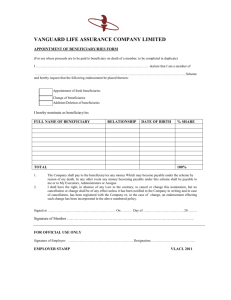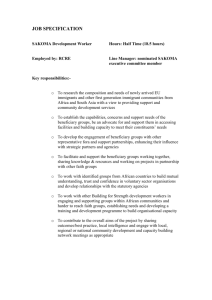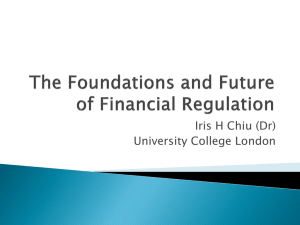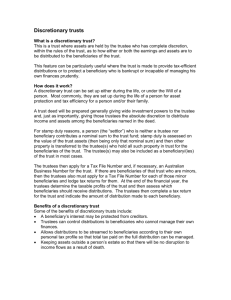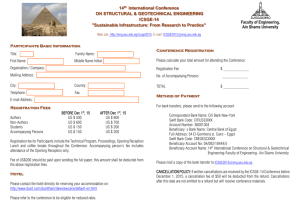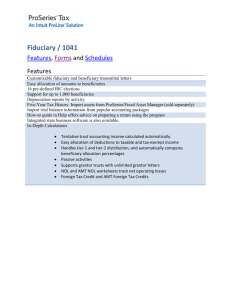Personal and Institutional Trusts Administrative Reviews
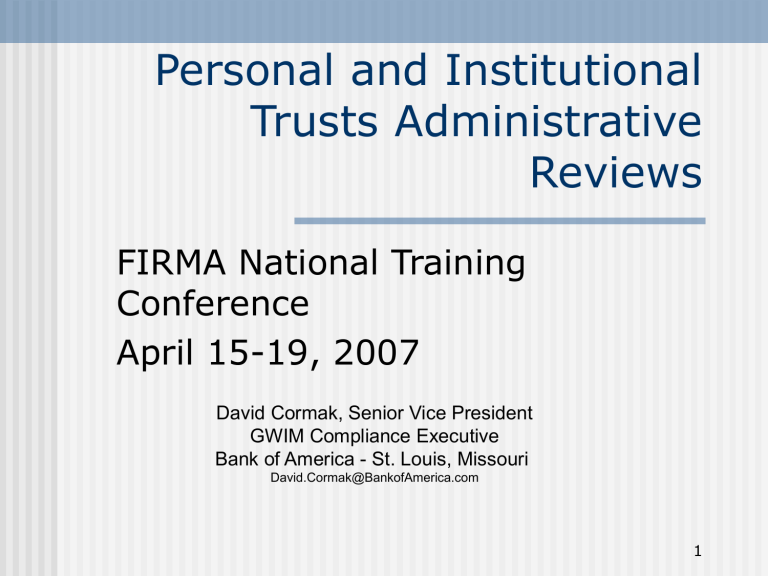
Personal and Institutional
Trusts Administrative
Reviews
FIRMA National Training
Conference
April 15-19, 2007
David Cormak, Senior Vice President
GWIM Compliance Executive
Bank of America - St. Louis, Missouri
David.Cormak@BankofAmerica.com
1
Disclaimer
The information contained in this presentation reflects the opinions of the author and not necessarily those of Bank of America
2
Agenda
What is an Administrative Review and why do it?
Regulatory expectations
The Risk/Reward Balance
Determining the Scope of an Administrative
Review
Risk Ranking accounts
Frequency of review
Elements to review
Other Process Considerations
Technology
Compliance/Risk Role
3
What is an Administrative
Review?
Administrative Review covers the synoptic coding and general administrative data of an account to ensure compliance with:
Terms of the governing instrument
Internal policies and procedures
Regulations
All applicable laws
4
What is an Administrative
Review?
It is not an annual investment review as required by Reg 9.
It can be as simple as reviewing synoptic coding to ensure it is in line with the governing instrument.
It can be as extensive as a full document review, updating a family tree, reviewing transactions, or ensuring all appropriate parties are receiving statements.
5
Regulatory Expectations
While there is no regulatory requirement to perform an Administrative Review, if you do perform them, the expectation is that you will:
Use a consistent process to review accounts.
Review your accounts on a regular basis.
Address any issues you identify as part of the process.
6
Why do an Administrative
Review?
It can be an effective management tool to manage risk and ensure compliance with the governing instruments.
However, it is not one size fits all.
7
The Risk/Reward Balance
The Risk/Reward analysis will vary by each organization’s unique circumstances:
Have there been mergers or major systems conversions?
Have there been recent negative exam or audit findings?
Is the account base comprised of a disproportionate number of high risk accounts?
How easy is it to gather the account information needed to do a review?
Do you need to invest in technology to track and report against the results?
What is the quality of your staff?
What is the status of your quality controls?
What is the capacity of your staff to absorb the additional work?
8
Risk/Reward Balance
Potential Benefits
Increased confidence:
That accounts are being administered in accordance with the key provisions of the governing document.
In the accuracy of key system coding.
In the accuracy of management reporting, fee calculations and distributions.
That appropriate actions will be taken at the time of a significant life event.
9
Risk/Reward Balance
Potential Benefits
Mitigate risk by identifying potential issues or opportunities.
Strengthen customer relationships by improving communication and service quality by having a better understanding of the terms and conditions of the agreement and accurate systems coding.
10
Risk Ranking of Accounts
Risk ranking accounts can help optimize your administrative reviews by:
Properly aligning resources with risk.
Focus management's attention on higher risk accounts.
Varying the frequency of reviews based on risk.
11
Risk Ranking of Accounts
Common risk ranking categories:
Account Type (Trust vs. Agency)
Revocability
Pledged Assets
Investment Responsibility
UPIA
Market Value
Multiple beneficiaries
Specialty (Unique) assets
Concentrations
Holding Bank Stock
12
Example of Review Schedule based upon Risk
High risk – most frequent
(every 6-12 months)
Medium risk – based on preset cycle
(every 12 -24 months)
Low risk – longest cycle
(every 24 to 36 months)
On an as needed basis, when a significant event occurs
13
Determining Scope to include on an Administrative Review
Review important administrative items such as:
Documents (original and amendments)
System coding (especially those that drive activity)
Verification of governing law
Tax documentation (W-9, W-8)
Statements to beneficiaries and third parties
14
Determining Scope to include on an Administrative Review
Unique account circumstances
Discretionary and other distribution provisions
KYC documentation
Documentation regarding key agreements
(fees, repetitive distributions, delegations, etc.)
15
Determining Scope to include on an Administrative Review
Overlay actual experience and consider adding elements that:
Regularly cost the firm money in losses.
Have been cited during recent audits or compliance reviews.
Are critical path items, even if they do not present current problems.
Regularly review the scope of the
Administrative Review in light of recent experience.
16
Determining Scope to include on an Administrative Review
Emerging areas for consideration:
Compliance with Privacy policy
Compliance with information protection process (systems access or data mining)
Obligations imposed by new laws such as
UPIA or the UTC
17
Other Process Considerations
Who will perform the reviews?
How will the results be documented?
Who has ultimate accountability for oversight of the process and resolution of exceptions?
Who ensures that unresolved exceptions are appropriately addressed?
Who is accountable for looking at the “big picture” to identify, monitor and address systemic issues?
18
Technology
Depending on the size of your organization, the state of your accounts and available resources, Excel might be sufficient technology.
Or you may find that the gains from time, cost and quality justify an expenditure on larger systems applications.
19
Key Technology Uses
Use technology to standardize your process.
Risk rank accounts based on systems coding.
Scan account information and automatically generate exceptions to be address based on predefined norms.
20
Key Technology Uses
Automatically generate review when an updated review is required while archiving the older reviews.
Use technology to create management reporting to track progress on reviews and track the correction of any exceptions found during review.
21
Key Technology Uses
Enable searches, filters and ad hoc reporting functionality.
Provide ability to create manual exceptions as needed.
22
Compliance/Risk Role
Depending on the risk and control model in place in your organization, you may play different roles in the process:
Participation in governance or oversight meetings.
Perform independent testing.
Tracking completion and mitigation of exceptions.
Identification and reporting of systemic issues.
23
Summary
Look at what makes sense for your organization – the Risk/Reward Equation.
Consider risk ranking items based on objective factors and emerging areas of risk.
Consider basing the frequency of your reviews on the risk profile of the account.
Use technology to make your process more efficient, identify and track corrected deficiencies.
24
Summary
The importance and impact of an
Administrative Review can be greatly elevated if it is considered a living process directed at the most significant current risk.
In other words, you can’t design it once and forget about it.
25
Questions?
26
Appendix
Failure Mode & Effects Analysis ratings
(FMEA)
Sample Administrative Review Questions
27
Rating Scale for FMEA
Rating
5
4
3
2
1
Severity of Effect
Almost certain loss of customers, reputational risk, and/or regulatory risk
High probability of customer dissatisfaction and lost business, reputational risk, and/or regulatory risk
Noticeable to customers resulting in potential for lost business, some reputational risk, and/or possible regulatory notice.
Minor defected noted by some customers and noticed by discriminating customers. Minor reputational risk.
Likelihood of
Occurrence
Very High:
Failure is almost inevitable
Ability to Detect
Little to no chance of detection
High: Repeated
Failures
Moderate:
Occasional
Failures
Low: Relatively few failures
Very low chance of detection
Moderate chance of detection
High chance of detection
No Effect
Remote: Failure is unlikely
Almost certain detection 28
Sample Administrative
Review Questions
1.
2.
3.
Have you reviewed a copy of the governing instrument, including all amendments and codicils on file?
Based on the governing instrument, are the account titles coded appropriately?
a.
b.
Is there a specific 5 and 5 withdrawal power stated in the governing instrument?
Is there evidence in the file that the current power holder is aware of their right to withdraw?
If no, a notice and copy of the governing instrument must be sent to the power holder.
29
Sample Administrative
Review Questions
4.
a.
b.
c.
d.
e.
f.
Is the firm or firm associate named as Attorney-in-Fact
Have we been notified of a POA for the beneficiary or settler?
Do we have an original or certified copy of the POA?
Have we confirmed that the beneficiary or settlor is alive?
Is the POA still in effect?
If POA is not durable, have we confirmed that the beneficiary or is still competent?
Have all distributions requested by the Attorney-in-Fact been made directly to a service provider, or to the beneficiary or grantor, or to an account in their name?
30
Sample Administrative
Review Questions
5.
6.
a.
b.
c.
d.
Beneficiaries a.
b.
c.
Are all required income and principal beneficiaries set up on the system?
Are proper beneficiaries receiving payments?
Are W-9s on file for all current beneficiaries?
Is the settlor or any current beneficiary mentally incompetent or a minor?
Do we have adequate documentation in the file?
Does the instrument have a facility of payment clause?
Are distributions being made in compliance with that clause?
If beneficiary is a minor, is a tickler established to alter payee upon age attainment?
31
Sample Administrative
Review Questions
7.
8.
a.
b.
Are there any beneficiaries, co-trustees, or grantors who are not U.S. citizens (NRAs)?
a.
b.
Do we have a W-8 on file?
If Grantor is an NRA, has the appropriate KYC approval from the NRA KYC unit been obtained?
Statements
Are the proper parties set up to receive statements?
If statements are not being mailed to a beneficiary or independent 3rd party, is the Committee set up to receive an annual statement?
32
Sample Administrative
Review Questions
9.
a.
b.
c.
Are we making recurring payments from the account?
According to the document and beneficiary information, are payments still appropriate under current account circumstances?
Have all clients receiving recurring income payments been contacted within the last year?
If account is a simple trust, is all the income being distributed to the beneficiaries as appropriate?
33
Sample Administrative
Review Questions
10.
11.
a.
b.
c.
Is there a co-fiduciary on the account?
Is there written approval in the file for general administrative duties?
Are there any specific decision-making powers granted to the co-trustee under the document?
If yes, are we complying with such powers?
a.
b.
Is this a discretionary account?
Are discretionary distributions allowed:
1) from Income?
2) from Principal?
Were appropriate approvals/ratifications obtained for all discretionary distributions made in the past 12 months?
34
Sample Administrative
Review Questions
12.
a.
Review the document for important dates/events (i.e. attainment of age, annual accumulated income
disbursements/transfers, etc.).
Are appropriate administrative ticklers established?
13.
a.
b.
c.
d.
Fee Review – Part 1
Is the account charged full fees in accordance with current
Fee Schedule?
Is the fee exception still appropriate for the account?
Is there a restrictive fee clause in the document or a separate fee agreement?
If yes, are we complying?
35
Sample Administrative
Review Questions
14.
15.
Fee Review – Part 2 a.
b.
c.
d.
e.
Is the fee coding correct?
Is this account subject to Court supervision?
Are all distributions made in accordance with a court order, applicable document, or state statute?
If accountings are to be sent to the court, have ticklers been established to ensure they are being sent?
Are necessary court orders and approvals of accountings on file?
1.
2.
Does the account hold Proprietary Funds (including
money markets)?
Are appropriate disclosures on file for sole authority accounts?
Is the signed authorization on file for co-trustee, IRA, or directed/advisory accounts?
36
Sample Administrative
Review Questions
16.
17.
18.
a.
b.
Are there any restrictive investment clauses in the document?
Does the document prohibit the use of Proprietary Mutual
Funds?
Are there other investment restrictions in the document?
c.
Are we complying with the noted restrictions?
Does the account hold any Specialty Assets?
a.
Are the appropriate units actively involved with the management of these specialty assets?
Are there any outstanding loans from the account to any borrowers, and/or has the account been pledged as collateral?
a.
b.
Is proper loan documentation on file?
Are payments current?
37
